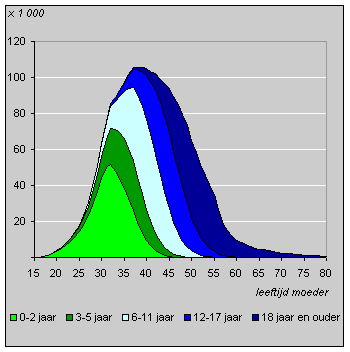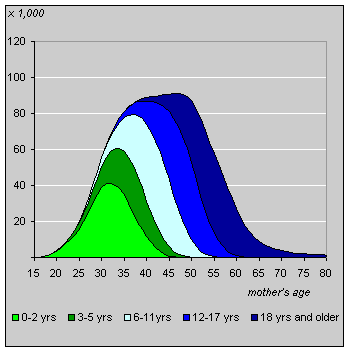More and more older mothers with children at home

Today, most women with one or more children living at home are aged between 35 and 40. In the future mothers older than this, too, will still have children at home: in 2050 the number of mothers with one or more children at home will only start to decrease after the age of fifty.
Women by age of youngest child, 2001

Mothers in 2001
At the moment the youngest child of most – some seventy percent – thirty year-old mothers is younger than three. By the age of 35 a minority of mothers – about forty percent – still have a toddler at home. The youngest child of one third of these mothers is aged between three and five, the youngest of another third between six and twelve.
The number of mothers who still have children living at home peaks around the age of forty. Three-quarters of forty year-old mothers no longer have very young children, and the youngest child of one quarter of them is already at secondary school. Nearly half of mothers aged around 45 have a youngest child aged between twelve and seventeen.
The youngest children of most women aged fifty are over eighteen, and hardly any sixty year-old mothers still have children at home.
Women by age of youngest child, 2050

Mothers in 2050
In 2050 many more older others will still share their homes with their children than in 2001. The reason for this is that Dutch women have been postponing motherhood in the last few decades. In 1975 women were aged 25 on average when they had their first baby, compared with an average age of 29 in 2001.
Although no further postponement in family formation is expected in the future, the delay in the past will have the effect that mothers will be increasingly older when their youngest child leaves home.
The differences between 2001 and 2050 are largest for the group of mothers aged fifty. About a quarter of these have a youngest child in of secondary school age in 2001, compared with half in 2050.
Andries de Jong